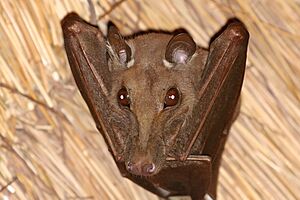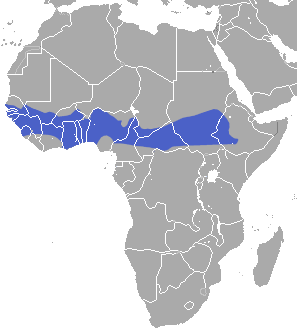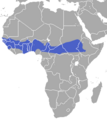Gambian epauletted fruit bat facts for kids
Quick facts for kids Gambian epauletted fruit bat |
|
|---|---|
 |
|
| Conservation status | |
| Scientific classification | |
| Genus: |
Epomophorus
|
| Species: |
gambianus
|
 |
|
| Gambian epauletted fruit bat range | |
| Synonyms | |
|
|
The Gambian epauletted fruit bat (Epomophorus gambianus) is a type of megabat. It belongs to the Pteropodidae family. You can find these bats in many countries across Africa. This includes places like Benin, Burkina Faso, Cameroon, and Ethiopia.
These bats usually live in dry forests and savannas. Sadly, their homes are shrinking. This is the biggest threat to them.
Gambian epauletted fruit bats have grayish-brown fur. They have a white patch at the base of each ear. Both males and females have these patches. These bats can also be quite noisy! Males make a bell-like 'ping' sound. They do this when they are trying to attract a mate.
Contents
What Makes Them Special?
It's easy to tell male and female Gambian epauletted fruit bats apart. Males are usually bigger than females. Males also have special skin pouches on their shoulders. These pouches are surrounded by light-colored fur. They look like fancy shoulder decorations called epaulettes. This is how the bat got its name! You can only see these "epaulettes" when the male bat is stressed. Both males and females have small, rounded ears. They also have a snout that looks a bit like a dog's.
Their bodies are usually about 12.5 to 25 centimeters long. Males have a wingspan of about 50.8 centimeters. They weigh between 40 and 120 grams. Their forearms are about 6 to 10 centimeters long. These bats also have a tail. It's often hard to see because it's hidden under a membrane between their legs.
During the day, these bats hang alone from evergreen trees. At night, they fly in groups of hundreds. They travel through the forests of Africa.
How They Behave
Gambian epauletted fruit bats love to eat fruit. They will show up wherever there are fig, mango, guava, or banana trees. These bats are very social. The whole group is organized. Young bats and non-breeding adults have their own separate areas.
These fruit bats travel in small groups of six to twenty. When they fly, they stay together in long lines. The leader often changes, but they keep flying in the same direction.
They often sniff each other's scent glands. This helps them recognize each other. It shows how organized they are. If one bat is hurt, others will fly low to check on it. This shows they care about each other.
During the day, they rest in mango trees or bamboo reeds. They hang upside down, alone or in groups of up to twenty. Their droppings help many other living things in the ecosystem. These bats eat nectar and fruits from West African trees. They help to pollinate flowers and spread seeds. Some flowering trees need bats for pollination.
At sunset, the groups move from their resting spots to feeding areas. To stay safe from predators, bats will carry fruit away from the tree before eating it. Over a few nights, bats can carry tons of seeds from one fig tree. This helps many new trees grow in different places. These bats spend over half their lives resting in various spots.
Some non-territorial males act as guards. They stay alert for any trouble. If they see something, they either make a loud alarm sound or stay still and watch.
Unlike many other bats, Gambian epauletted fruit bats use their sight to find food. They don't use echolocation. They also use their strong sense of smell. This helps them find food and form bonds with other bats.
What They Eat
These bats mainly eat small fruits. They often fly from tree to tree, feeding on their favorite food: figs. Figs are not very nutritious. They have little protein and a lot of sugar. But figs are very common. So, bats must visit many trees to get enough nutrients. This energy is needed for flying and feeding their young.
These bats also eat other fruits. They enjoy bananas, mangoes, and guavas. They also drink nectar from Parkia biglobosa flowers. But figs are their main food because they are available for longer. Gambian epauletted fruit bats can spend eight to ten hours flying and eating. They burn a lot of energy flying.
It's very important for these bats to get enough food. If they don't, they won't have enough nutrients for their babies. Young bats don't stay in a nest. Instead, they hold onto their mother's teats while she flies. They do this until they are about five weeks old. Then, they start to learn to fly and lose their baby teeth.
Reproduction and Life Cycle
Male and female Gambian epauletted fruit bats look different. This is called sexual dimorphism. Males are usually bigger than females. Males also have special pouches on their shoulders. These pouches are surrounded by light-colored fur. They look like epaulets, which is how the species got its name.
The mother bat is pregnant for about six months. This is called the gestation period. Pregnant females will rest away from the males. Usually, only one baby bat is born at a time.
The baby bat doesn't grow much inside the mother at first. This delay helps make sure the baby is born when there is plenty of food. This is important for mothers. They need a lot of energy to feed their babies.
Newborn bats grow very quickly. Different parts of their bodies grow at different rates. At birth, their thumbs and back feet are almost full size. They don't grow much more. But their forearms and other wing bones grow fast. An adult's wing area is 10 times bigger than a newborn's! They gain weight quickly while drinking their mother's milk. Once they start eating fruit, their weight might drop. They use up the fat they stored while nursing.
Baby bats are born with special milk teeth. These teeth aren't for eating solid food. They help the babies hold onto their mother's teats. The baby teeth fall out when the bats learn to fly. At the same time, their permanent teeth grow in. Then they can start eating fruit.
These bats can live a long time for a small mammal. Most epauletted fruit bats live up to 28 years. On average, they live about 21 years. Scientists are still learning why bats live so long.
Where They Live
Fruit bats are tropical animals. But some species live where fruit is only available for part of the year. For example, in East Africa, Gambian epauletted fruit bats might eat figs during the rainy season. But during the dry season, they might fly hundreds of miles. They need to find a different climate where other trees have fruit.
The Gambian epauletted fruit bat lives across a wide area of Africa. This includes countries like Angola, Botswana, Democratic Republic of the Congo, and Zambia. They usually live in low areas, below 500 meters above sea level. But in Ethiopia, some have been found as high as 2,000 meters.
These bats can adapt to many different environments. They live in dry savannas, moist savannas, and tropical dry forests. They have also been seen in damaged forests, mangroves, and swamp forests. These bats prefer to live at the edge of forests. They rest in thick leaves, roots along stream banks, under sheds, and in large tree hollows.
They usually rest alone or in small groups. They can roost low in trees during the day. They don't seem bothered by people nearby. They even live in areas with a lot of light. These bats have moved into farm areas. They can be found in orchards with bananas, figs, mangoes, and guavas. This is because humans are building homes in their natural habitats.
Images for kids




